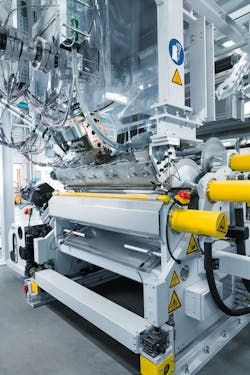SML has developed an extrusion line for producing foamed PET sheet that can withstand contact with hot substances and has a high-quality, printable surface. Such sheet can be thermoformed into cups for hot beverages or used in traditional applications, such as the manufacture of thermoformed trays.
The same line, available in various configurations, also can produce rigid PET sheet and foamed and rigid PP sheet.
A proprietary system for gas injection and melt treatment creates a melt with a consistent viscosity, according to the company. It accomplishes this by maintaining stable melt properties like temperature, homogenization and pressure.
The system introduces low-cost nitrogen or carbon dioxide into the extruder barrel, where it is mixed into the melt, said Max-Phillip Lutz, product manager for sheet extrusion, for the Redlham, Austria, company.
Physical foaming is less expensive and cleaner than chemical foaming, and it results in no die-lip deposits, the company said. In addition, the changeover from foamed sheet to rigid sheet extrusion is faster and easier because there is no need to purge or clean the resin-dosing system or extruder, and there is no danger of chemical residues contaminating the rigid sheet after the changeover.
Manufacturers can easily change the overall sheet density by using the installed control system. The ability to store recipes allows operators to quickly and efficiently switch the line between foamed and rigid sheet, he said.
A typical PET A/B/A structure would consist of a foam core comprising up to 85 percent of the sheet thickness and would weigh half as much as rigid sheet.
SML will customize the extrusion line to accommodate customers’ needs, said Mark Jones, director of support services for SML North America Service Inc.
A typical extrusion line suitable for both virgin and post-consumer resin would include two single-screw extruders. For processing PET and other hygroscopic resins, the line would also include drying equipment.
The new extrusion line can produce foamed sheet with an inner layer of post-consumer resin and outer layers of virgin material, allowing the sheet to meet FDA requirements for contact with food. If a company wanted to make a cup with different colors on the inside and outside surfaces, a third extruder could be added to produce an A/B/C structure.
The extrusion line includes a three-roll cooling stack, which gives the sheet a smooth, printable surface. The gap on the cooling stack is adjustable to accommodate sheet that requires low nip pressures; however, the stacks can produce the high nip forces required for traditional rigid sheet, Jones said.
This flexibility allows processors to run the line continuously with foamed or rigid product, even as demand for PET and PP foamed sheet continues to develop, Jones said.
“The line itself would be configured to make it best for foamed PET and foamed PP, but it’s also perfectly capable of running non-foamed rigid solid sheets,” Jones said.
The extrusion line is available in six standard roller widths ranging from about 3.5 feet to 6.6 feet that are capable of producing sheet ranging from about 3 feet to 6 feet, Lutz said. Other widths are available on request, he said.
Foamed PET sheet is a good insulator, and is lightweight and easy to recycle. Cups thermoformed from foamed PET sheet are lighter without sacrificing the rigidity needed for the cup to hold its shape. When used to hold hot beverages, no protective sleeve is necessary, resulting in further material savings.
Mono-material foamed PET or PP sheet produced on SML’s new systems can replace difficult-to-recycle PS. Unlike PS, the infrastructure for recycling PET already exists in many places. Products made of foamed PET sheet can be easily processed with other single-use PET products.
SML worked with Kiefel Technologies to develop the technology for thermoforming foamed PET sheet into containers that can withstand beverages as hot as 212 degrees Fahrenheit. The companies have succeeded in producing heat-resistant cups extruded from up to 40 percent bottle flake and 60 percent virgin resin. They are continuing to cooperate on research to optimize the manufacturing processes and develop new recycling methods.
Bruce Geiselman, senior staff reporter
SML North America Service Inc., Gloucester, Mass., 978-281-0560, www.sml.at
Bruce Geiselman | Senior Staff Reporter
Senior Staff Reporter Bruce Geiselman covers extrusion, blow molding, additive manufacturing, automation and end markets including automotive and packaging. He also writes features, including In Other Words and Problem Solved, for Plastics Machinery & Manufacturing, Plastics Recycling and The Journal of Blow Molding. He has extensive experience in daily and magazine journalism.
Bandera reports cybersecurity incident
Nordson appoints regional sales manager






